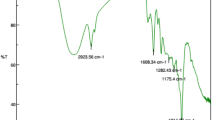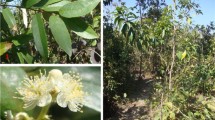Abstract
The antibacterial activity of Aloe barbadensis was tested on clinically isolated bacterial pathogens i.e. Enterococcus bovis, Staphylococcus aureus, Escherichia coli, Proteus vulgaris, Proteus mirabilis, Pseudomonas aeruginosa, Morganella morganii, and Klebsiella pneumoniae causing infection in human being. Ethanolic and aqueous extracts were used for the antibacterial effect, which was measured by the appearance of zone of inhibition. Relatively higher MIC concentrations were obtained for gram negative bacteria E. coli and K. pneumoniae, with ethanol extract; however, no inhibitory effect was noted for aqueous extract. Ethanolic extract possesses great inhibitory activity for gram positive bacteria, E. bovis followed by S. aureus. Among gram negative bacteria, highest inhibitory effect was observed with P. aeruginosa, followed by M. morganii, P. mirabilis, and P. vulgaris, which was significant (p < 0.01) than E. coli and K. pneumoniae. Antimicrobial activity tests of crude extract of A. barbadensis were carried out to validate the use of traditional medicinal herbal and results of this study tend to give credence to the common use of A. barbadensis gel and leaf.

Similar content being viewed by others
References
Habeeb, F., Shakir, E., Bradbury, F., Cameron, P., Taravati, M. R., Drummond, A. J., et al. (2007). Methods (San Diego, California.), 42, 315–320. doi:10.1016/j.ymeth.2007.03.004.
Tan, B. K., & Vanitha, (2004). Current Medicinal Chemistry, 11, 1423–1430.
Karthikeyan, B., Jaleel, C. A., Lakshmanan, G. M. A., & Deiveekasundaram, M. (2008). Colloids and Surfaces. B, Biointerfaces, 62, 143–145. doi:10.1016/j.colsurfb.2007.09.004.
Rodriguez-Fragoso, L., Reyes-Esparza, J., Burchiel, S. W., Herrera-Ruiz, D., & Torres, E. (2008). Toxicology and Applied Pharmacology, 227, 125–135. doi:10.1016/j.taap.2007.10.005.
Bergamante, V., Ceschel, G. C., Marazzita, S., Ronchi, C., & Fini, A. (2007). Drug Delivery, 14, 427–432. doi:10.1080/10717540701202960.
Tyler, V. (1995). The honest herbal: A sensible guide to the use of herbs and related remedies. Binghamton: Pharmaceutical Products.
Online: Hallowitz, R. (2005) Library of abstracts of peer-reviewed professional journal articles on Aloe vera, with introduction and editorial commentary. Available from: http://br-plus.com/herbalabstracts/aloevera/library.htm. Accessed December 31, 2008.
Grindlay, D., & Reynolds, T. (1986). Journal of Ethnopharmacology, 16, 117–151. doi:10.1016/0378-8741(86)90085-1.
Stanić, S. (2007). Archives of Biological Sciences (Belgrade), 59, 223–226.
Agarry, O. O., Olaleye, M. T., & Bello-Michael, C. O. (2005). African Journal of Biotechnology, 4, 1413–1414.
NCCLS. (2000). Methods for dilution antimicrobial susceptibility tests for bacteria that grow aerobically (5th ed.). Approved standard M7-A5. Wayne.
MacKenzie, F. M., Bruce, J., Van-Looveren, M., Cornaglia, G., Gould, I. M., & Goossens, H. (2006). Clinical Microbiology and Infection, 12, 1185–1192. doi:10.1111/j.1469-0691.2006.01549.x.
Janssen, A. M., Scheffer, J. J., & Baerheim-Svendsen, A. (1987). Planta Medica, 53, 395–398. doi:10.1055/s-2006-962755.
Coopoosamy, R. M., & Magwa, M. L. (2007). African Journal of Biotechnology, 6, 2406–2410.
Sokal, R. R., & Rohlf, F. J. (1995). In Biometry, the principles and practice of statistics in biological research (pp. 321–356, 3rd ed.). New York: WH Freeman and Company.
Davis, H. R. (1997). Aloe vera: A scientific approach. New York: Vantage.
Kelmanson, J. E., Jager, A. K., & Van-Staden, J. (2000). Journal of Ethnopharmacology, 69, 241–246. doi:10.1016/S0378-8741(99)00147-6.
Acknowledgement
The authors are grateful to the Head, Department of Medical Biochemistry and Secretary, Uttarakhand Forest Hospital Trust Medical College, Haldwani, India for their support, encouragement and providing research facilities. Department of Medical Microbiology, Uttarakhand Forest Hospital Trust Medical College, Haldwani, India is duly acknowledged for providing pure culture of clinically isolated bacterial pathogen.
Author information
Authors and Affiliations
Corresponding author
Electronic supplementary material
Below is the link to the electronic supplementary material
ESM 1
(PDF 712 KB)
Rights and permissions
About this article
Cite this article
Pandey, R., Mishra, A. Antibacterial Activities of Crude Extract of Aloe barbadensis to Clinically Isolated Bacterial Pathogens. Appl Biochem Biotechnol 160, 1356–1361 (2010). https://doi.org/10.1007/s12010-009-8577-0
Received:
Accepted:
Published:
Issue Date:
DOI: https://doi.org/10.1007/s12010-009-8577-0




